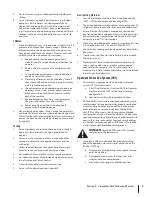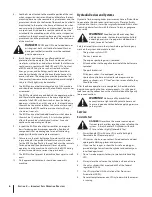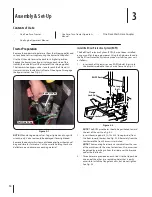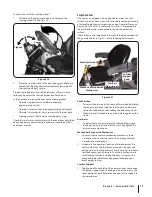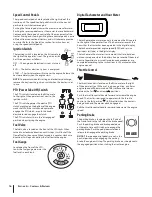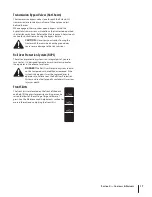
6
s
ectiOn
2 — i
MpOrtant
s
afe
O
peratiOn
p
ractices
Seat belts are attached to the movable portion of the seat
4.
when suspension seats are utilized, and therefore the seat-
mounting base must be secured to its pivot means and the
pivot means latched to the frame of the machine. Seat belts
are attached to the seat or the frame of the machine when
non-suspension (standard) seats are provided, however, if
a suspension kit is added to a seat, the seat belt must be
attached to the movable portion of the seat or suspension
mechanism, the seat-mounting base must be secured to its
pivot means, and the pivot means be latched to the frame
of the machine.
DANGER!
If ROPS and OPDs are folded down or
missing, seat belts shall not be fastened. Worn or
damaged seat belt assemblies must be replaced
prior to operator use.
Brush Guards and canopies can afford additional
5.
protection for the operator. The Brush Guard can deflect
tree limbs, clothes lines, and other obstacles that otherwise
could come in contact with the ROPS and OPDs. Contact
of ROPS and OPDs by items such as tree limbs, clothes
lines, guy wires, and buildings, could create hazardous
conditions whereby the machine could experience a tip-
over or roll-over. The canopy can provide protection for
the operator from some environmental exposure (sunlight,
rain, etc.). Work lights may be available.
The ROPS and seat belt are integral parts of this machine
6.
and should not be tampered with, modified in any manner,
or removed.
The ROPS extends above and behind the operator position,
7.
and therefore the operator must be aware of potential
contact of the ROPS with items such as trees, buildings,
doorways, clothes lines, utility wires, etc., that could cause
the machine to upset or rollover. Use caution in (or avoid)
areas where the ROPS could come in contact with any
structures, trees, etc.
The ROPS and seat belt add additional mass that elevates
8.
the machine’s Center of Gravity (C.G.) which negatively
affects the machine’s stability and traction. Use extra
caution when operating on slopes.
Inspect the ROPS and seat belt assemblies on a regular
9.
basis for damage and improper operation. Replace all
components that are damaged or are not functioning
properly with authorized replacement parts.
Fail
10.
ure to use the seat belt properly could result in serious
injury or death if an accidental overturn occurs. In order
for the ROPS to be effective, the seat belt must be securely
fastened around the operator at all times when the
operator is on the machine. Contact with the ROPS during
an overturn could cause serious injury or death.
The ROPS will not prevent the machine from upsets or roll
11.
overs.
Only approved attachments should be used on this
12.
machine.
Hydraulic Devices and Systems
Hy
draulic fluid escaping under pressure may have sufficient force
to penetrate skin and to cause serious injury. If foreign fluid is
injected into the skin, it must be surgically removed within a few
hours by a doctor familiar with this form of injury, or gangrene
may result.
WARNING!
Keep body and hands away from
pinholes or nozzles that could eject hydraulic fluid
under high pressure. Use paper or cardboard, not
hands, to search for leaks!
Safely reliev
e all pressure in the system before performing any
work on the system, and make sure that:
The ignition switch is OFF
•
The key is removed
•
The engine spark plug wire(s) removed
•
All connections to the negative terminal of the battery are
•
removed
The park brake is set
•
All by-pass valves, if so equipped, are open
•
Hydrau
•
lic controls are actuated to release pressure on
pumps, cylinders, etc. If “float” positions are available, they
should be used
.
After the above operations are completed, it should be safe to
begin disconnecting the lines or components. It is still a good
idea to cover the connection with a cloth shield and then gently
loosen connections.
WARNING!
Make sure all hydraulic fluid
connections are tight and all hydraulic hoses and
lines are in good condition before applying pressure
to the system.
Service
Related to Fuel
DANGER!
Never have the mower near an open
flame or spark, or allow smoking when refueling the
system. Always handle LPG cylinders with care.
LPG is a safe but highly flammable fuel.
Always handle LPG with care. LPG is a safe but highly
1.
flammable fuel. Please respect it.
LPG causes skin burns on contact. Aviod contact and wear
2.
appropriate clothing, gloves and eyewear.
If you smell or see gas, or hear the hiss of escaping gas,
3.
immediately get away from the cylinder and contact your
local fire department.
Do not smoke or permit others to smoke while handling
4.
LPG.
Always close the valves on the cylinders when not in use.
5.
Use only cylinders that meet code #49 of the federal
6.
regulation #173.34.
Use LPG classified HD-5 by national Gas Processors
7.
Association (nGPA).
never attempt to remove an LPG cylinder while the mower
8.
is running.
Содержание Tank S S7237
Страница 45: ...Notes 12 45 ...





